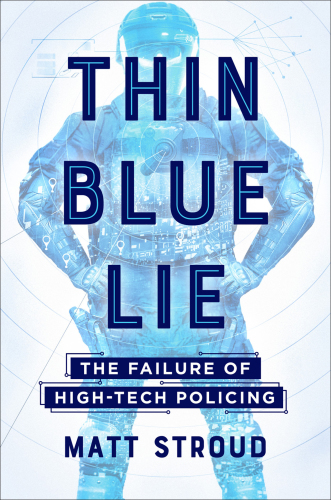
Thin Blue Lie
The Failure of High-Tech Policing
کتاب های مرتبط
- اطلاعات
- نقد و بررسی
- دیدگاه کاربران
نقد و بررسی

January 1, 2019
An exploration of how high-tech advancements in law enforcement are failing.Journalist Stroud has developed a specialized beat for periodicals about corporations who develop technologies for law enforcement agencies and prisons. In this overview, he shows pointedly that technological devices--including Tasers, body cameras, computerized crime control, facial recognition software, surveillance cameras in public places, and cellphone tracking--may make policing more convenient but do not lead to better outcomes. Much of the narrative is historical, as the author explains how law enforcement evolved in the United States. He takes readers back to 1905, when Berkeley, California--like many cities at the time--lacked a police department. So an ambitious local resident named August Vollmer created a law enforcement unit and sought out whatever firepower technology could provide. Some of Vollmer's ideas--hiring educated officers, reaching out directly to neighborhoods (although more enthusiastically to white enclaves than those with people of color)--were progressive. However, the brute force Vollmer employed set the tone. A century later, Stroud explains, the massive police departments that can most easily afford technology, especially Los Angeles and New York City, are the leaders, with smaller departments often following examples that may be counterproductive. The author's primary narrative thread involves the development and marketing of stun guns, which are often referred to by the name of one brand, the Taser. Though Stroud's lengthy discussions about the financial hurdles faced by stun gun manufacturers become tiresome, on the whole, the author writes clearly and compellingly, and he shows how some companies oversold their technologies to police based on a desperation for profits. Stroud also weaves in concerns about ethics and civil rights and how, often, "the confidence that politicians place in [the technology] reflects an oversimplified understanding of the underlying difficulties."A useful book. Wisely, Stroud never loses sight of an overriding reality: that technology is never a substitute for compassionate policing based on trust between cops and the citizens they are paid to serve.
COPYRIGHT(2019) Kirkus Reviews, ALL RIGHTS RESERVED.

March 1, 2019
With communities enraged both by rising crime and deadly force used by police, law enforcement agencies have been exploring alternative means to combat the use of deadly force on suspected criminals. Highly technological devices have evolved to help combat criminal activities. Journalist Stroud investigates the impact of high-tech policing by examining the various devices, including the Taser, Compstat, facial recognition software, surveillance cameras in public places (CCTV), cellphone tracking, and body cameras. Stroud reveals that many companies oversell their technologies, often using former law enforcement officers as sales representatives. While cities such as New York and Los Angeles have bought into many of the expensive technological devices, they do not necessarily make communities safer and have not been proven effective in reducing the use of deadly force, argues Stroud. VERDICT This eye-opening account abounds with vigorous investigative work that exposes the myth of high-tech policing. Highly recommended.--Michael Sawyer, Daytona Beach, FL
Copyright 2019 Library Journal, LLC Used with permission.

March 25, 2019
Investigative reporter Stroud delivers a rousing condemnation of “technological solutionism” in police departments. “Adherents of the philosophy,” he writes, “have looked to electroshock weapons, statistical analysis, CCTV, facial recognition, body cameras, and a host of other technologies to supposedly make policing more efficient and humane” but often backfire, instead of undertaking “substantial institutional reform—which can be messy and requires a tough accounting of what’s working and what isn’t in a police department.” He identifies the start of this trend in the changing demographics in cities, where white flight in the 1950s increased segregation and intensified policing. According to Stroud, technology became the typical police response to crime and to increased racial tensions. Stroud reviews policing technology from early-20th-century police captain August Vollmer’s use of the lie detector test in 1921 up to the present trend of police body cameras; in between, he discusses the emergence of COMPSTAT, a policing and crime tracking system that fed into the broken-windows model of policing, and the rise of the Taser, intended to be a nonlethal weapon but nevertheless an instrument of death in many cases. Stroud opines that technological solutions in policing, while perhaps useful, will not address the underlying cultural deficit in empathy and compassion among police. This is a meticulous and fascinating study.

























دیدگاه کاربران